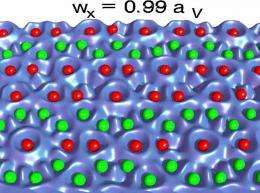In a simulation, colloids rearrange themselves when a phasonic drift is applied (screenshot from video below). Image credit: Kromer, et al. ©2012 American Physical Society
(Phys.org) -- When illuminated by laser light, assorted colloidal particles can arrange themselves into highly ordered structures called quasicrystals. By changing the phases of the lasers, researchers can force the colloids to further rearrange themselves in different ways. These collective rearrangements occur due to phasons, one of the many unique properties of quasicrystals.
Although scientists have observed the effects of phasons in quasicrystals, there are two different ways to theoretically describe what a phason is. Now in a new study, physicists have presented a way to look at phasons that links the two descriptions, providing a clearer picture of this unusual atomic motion that contributes to the uniqueness of quasicrystals.
The physicists, Justus A. Kromer and Holger Stark from the Berlin Institute of Technology, Michael Schmiedeberg from Heinrich Heine University in Dusseldorf, Germany, and Johannes Roth from the University of Stuttgart, have published their paper on phasons in a recent issue of Physical Review Letters.
Quasicrystals have intrigued scientists ever since they were discovered by materials scientist Dan Shechtman in 1982, for which he won the 2011 Nobel Prize in Chemistry. They are unusual in that they have order, but – unlike conventional crystals – they are not periodic, and so do not have translational symmetry. The result is a structure with an elegant-looking and complex atomic pattern.
Phasons are one of many properties of quasicrystals that do not exist in conventional crystals, but there are a couple different ways to theoretically describe them. Using fluid dynamics theory, scientists can describe phasons as a hydrodynamic mode, or a continuous pattern of motion. In this view, phasons might be thought of as a pattern of motion in which atoms rearrange themselves, similar to how phonons are described as a pattern of motion in which atoms vibrate (back and forth motion).
A single colloid changes position under an applied phasonic drift, which causes the positions of local energy minima and maxima to change. Video credit: Kromer, et al. ©2012 American Physical Society
From another perspective, phasons are viewed not as continuous motion but as collective jumps or “flips” of atoms to new sites. When described this way, phasonic dynamics are calculated in a different context using different equations.
In the new study, the physicists show how these two descriptions of phasons can be combined by using a model of colloidal particles. They developed simulations in which five interfering laser beams can force a suspension of colloidal particles into a quasicrystal structure. By tuning the lasers, they could create a phasonic drift that causes atomic displacement.
Colloids collectively rearrange themselves when an applied phasonic drift causes the positions of local energy minima and maxima to change. Video credit: Kromer, et al. ©2012 American Physical Society
“We study colloids in an external laser potential,” Schmiedeberg told Phys.org. “To implement the changes of the potential that correspond to a phasonic drift, we use a continuous description of the phasons. The resulting colloidal trajectories show phasonic flips.”
By studying colloid trajectories, the scientists found that a colloid barely moves when sitting at a local minimum, or position of low energy. But a phasonic drift of the potential can make this minimum disappear, which causes the colloid to slide into another local minimum, corresponding to a phasonic flip. So by analyzing the positions of minima or maxima, the researchers could predict the phason-induced rearrangements of atoms in a quasicrystal.
While researchers have previously observed the effects of individual phasons, they have not yet been able to study the pattern of the particles’ collective motion due to a phasonic drift, until now.
“We introduced a new method that helps to predict the collective motion of particles due to phasonic modes in a quasicrystal,” Schmiedeberg said. “We hope that our work will inspire future studies on the nature of phasons. A deeper insight into phasonic rearrangements will help to understand how the material properties of a quasicrystal depend on phasonic modes.”
He explained that a better understanding of phasons could extend the potential applications of quasicrystals:
“Quasicrystals have very special material properties and therefore are possible candidates to develop new materials. For example, they are already used for anti-stick coatings. Furthermore, they have special electric and mechanical properties and might be used as catalysts. Colloidal quasicrystals might be interesting to develop photonic structures.
“Phasonic modes can be thermally activated and therefore change the material properties of a quasicrystal, e.g., the specific heat, the ductility, the electric resistance, etc. In order to predict these properties from theoretical models, the nature of phasonic modes has to be understood.”
More information: Justus A. Kromer, et al. “What Phasons Look Like: Particle Trajectories in a Quasicrystalline Potential.” PRL 108, 218301 (2012). DOI: 10.1103/PhysRevLett.108.218301
Journal information: Physical Review Letters
Copyright 2012 Phys.org
All rights reserved. This material may not be published, broadcast, rewritten or redistributed in whole or part without the express written permission of PhysOrg.com.






















